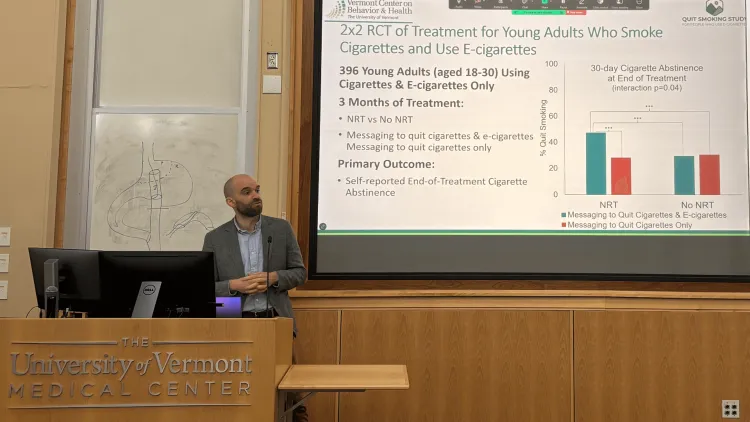Electronic cigarettes have been sold in the U.S. for two decades, but their use by young adults has increased dramatically during the past few years. Many people ages 18–29 use e-cigarettes, also called vaping, in addition to smoking traditional cigarettes. This dual tobacco use changes how people use nicotine in ways that could affect long-term risks for cancer, cardiovascular disease, and other tobacco-related harm. Despite rising dual use of smoking and vaping, there has been a notable lack of research on smoking cessation treatments for young adults.
New research led by Elias Klemperer, Ph.D., assistant professor of psychiatry at University of Vermont (UVM) Larner College of Medicine, reveals an effective approach for young adults to quit both smoking and vaping. The findings, published June 25, 2025, in the journal Nicotine and Tobacco Research, indicate that nicotine replacement therapy (NRT)—using products containing low, controlled doses of nicotine to keep cravings at bay—combined with simultaneous support to stop using cigarettes and e-cigarettes is effective in helping young adults quit smoking. The findings further suggest that pairing these tobacco cessation methods can enhance prolonged abstinence from tobacco products, improving young people’s health for the long term.
“This clinical trial is exciting because it provides evidence for an accessible treatment that can help young adults … before developing irreversible damage from cigarette smoking.” — Elias Klemperer, Ph.D.
Klemperer, who serves as associate director of the Vermont Center on Behavior and Health and a UVM Cancer Center member, led the research team that included UVM graduate students and postdoctoral fellows. The study involved 396 dual users, men and women ages 18–29, making it the largest trial to date of smoking cessation medication for people who use both cigarettes and e-cigarettes. The study method employed a 2x2 factorial trial, which means it assessed the effects of two or more factors. Participants were randomly chosen to receive 12 weeks of some combination of NRT or no NRT to stop cigarette smoking, and treatment that consisted of texts with encouragement either to quit or to continue using e-cigarettes when quitting cigarettes. Participants self-reported their progress throughout the 12-week treatment period.
Smoking cessation was greatest for those who received NRT along with texts encouraging them to quit e-cigarettes, at 47.1 percent compared to 29.2 percent for those who received texts to quit e-cigarettes but did not receive NRT, and 28.1 percent for those who received NRT along with texts telling them to continue using e-cigarettes. These findings show that NRT along with encouragement to quit using e-cigarettes is effective in getting young adults to quit both products.

This research was supported by a grant from the National Institute of General Medical Sciences through the Food and Drug Administration and the National Institute on Drug Abuse and a grant from the National Institute on Drug Abuse from the National Cancer Institute.
“One thing I appreciate about this kind of research is the potential to have an impact,” Klemperer says. “Cigarette smoking kills nearly half a million people per year in the United States alone, around 7 to 8 million worldwide every year. These are premature, preventable deaths. This clinical trial is exciting because it provides evidence for an accessible treatment that can help young adults who are using cigarettes and e-cigarettes quit now, before developing irreversible damage from cigarette smoking.”
Read the study in Nicotine & Tobacco Research
Research like this has contributed to the University of Vermont’s designation by the Carnegie Classification of Institutions of Higher Education as an R1 institution, placing it in the top tier of research universities in the U.S.

